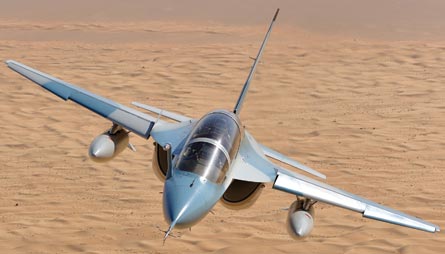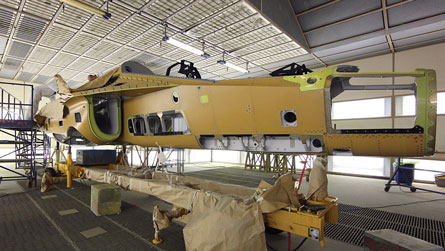Alenia Aermacchi and EADS Defence & Security used the Berlin air show to present the main topics of their joint response for the Advanced European Jet Pilot Training (AEJPT), or Eurotraining programme.
Staged at the Berlin air show on 9-10 June, the Fourth Future Military Pilot Training Conference provided a platform for the companies to detail the response to a request for information issued by the European Defence Agency (EDA) on 15 July 2009.
Following the signature of a memorandum of understanding between the Finmeccanica company and EADS's DS division last December, the companies created a multinational team to answer the RFI with an integrated training system (ITS), based on the M-346 Master advanced jet trainer.
 The M-346 is at the heart of an Alenia Aermacchi/EADS bid for Eurotraining. Picture: Alenia Aermacchi |
|---|
Their proposal is to meet the specific requirements of the nine European countries involved in the programme: Austria, Belgium, Greece, Finland, France, Italy, Portugal, Spain and Sweden.
"We have created a multinational team involving companies from five [Finland, France, Italy, Portugal and Spain] of the nine AEJPT contributing countries, proposing a common European ITS," says Bruno Lamarque, senior sales director, training services at EADS Military Air Systems.
The teaming "exploits all possible synergies and envisages further companies' involvement in the field of ground-based training systems [GBTS], engine production and maintenance, repair and overhaul", he adds.
In addition to the current partners, discussions are ongoing with other companies from Finland, Greece, Portugal and Spain.
Industry sources say a development programme for the Eurotraining system would see a European company involved with producing the M-346's Honeywell ITEC F124-200 engines, with other opportunities to come with providing ground-based training equipment.
Further industrial involvement could be secured from potential members such as Germany, which is an observer to the AEJPT programme, or from eastern Europe, they add.
To answer the RFI, responses for which were submitted in mid-March, the joint team "offers a fully integrated training service for advanced jet pilot training up to the operational conversion unit, based on the M-346, located on two air bases for up to 90 student pilots each", Lamarque says.
The fleet will be "optimised to meet the member countries' needs, and provide all ground training instructors, together with state-of-the-art GBTS", he adds. However, the EDA has yet to decide whether the future system could be established using a private finance initiative model.
COMPLIANT
"Our proposal is fully compliant with the requirements, thanks to the M-346's quadruple fly-by-wire flight control system, carefree handling, twin-engine, low fuel consumption, advanced aerodynamics and digital avionics with an embedded tactical training system," says Emanuele Merlo, Alenia Aermacchi's vice-president, flight technologies, ITS.
The aircraft will also be equipped with a datalink, enabling it to work in a fused real/virtual training environment, where pilots in flight can "play" together with colleagues in other aircraft, or on the ground in a simulator.
The M-346 team says its strength is also based on the activities developed by EADS DS in the field of fully integrated training services. This includes the French air force's basic pilot training system at Cognac air base, run by the company's EADS Cognac Aviation Training Services subsidiary and using 18 Grob G120s.
The school provided more than 50,000 flight hours between April 2006 and June 2009, and last year achieved a 98.5% availability rate.
"The proposed solution is derived from the already developed [M-346] training aircraft, embedded tactical training system and corresponding GBTS being deployed to fulfil the requirement of the Italian air force," Merlo says. "This will allow rapid, low-risk deployment to the AEJPT customer-selected air bases."
The Italian defence ministry's General Directorate of Air Armaments awarded Alenia Aermacchi a contract in November 2009 to supply its air force with 15 M-346 trainers. The type is now in production for the service, with a new production and final assembly line to be fully operational later this year at its Venegono plant.
This is structured on the basis of a "moving-line", with three main assembly cells for the aircraft's forward, central and aft fuselage. It will also feature a structural assembly section for its wing, a completion zone and a marry-up cell, plus an adjacent final assembly line and pre-flight testing station.
The facility will have an initial production rate of 24 aircraft a year, but this could be increased to up to 40, based on customer demand.
Activities are already under way on a smaller facility, which will be used to support development and aircraft pre-production assembly work. This will deliver the Italian air force's first two T-346As in December 2010, followed by a four-aircraft block in 2011. The last two of these will be completed using the new production and final assembly line.
 |
|---|
Italy's first T-346A is already in production. Picture: Alenia Aermacchi |
Six months away from receiving its first new advanced/lead-in fighter trainers, the Italian air force's experimental unit at Pratica di Mare air base near Rome is preparing itself to begin an intensive one-year operational test and evaluation phase. This will lead to the introduction into operation of the T-346A with the service's Flight School (61st Wing) at Lecce air base.
According to its launch order, prime contractor Alenia Aermacchi will be responsible for delivering 15 advanced trainers, along with GBTS equipment and a "turnkey" package of support. This includes aircraft maintenance and logistics services for an initial five years, along with personnel training and the construction of new facilities, to be delivered under a two-phased approach.
The first of these includes six T-346As and the majority of the ground-based training package, plus initial logisitics support and infrastructure work to accommodate the aircraft at Pratica di Mare and Lecce.
The air force's Flight School at Lecce now graduates military jet pilots and instructors using Alenia Aermacchi MB-339A/CDs, providing the Phase III and Phase IV elements of the service's flight training syllabus.
Delivery of the new advanced training package will elevate Lecce's flight school to a higher level in the international domain. It already hosts instructors from nations including Argentina, France and Greece, and a first cadre of Greek pilots also recently completed an advanced lead-in fighter training course at the site.
More countries have already sent students or are discussing agreements with the Italian defence ministry and air force to potentially make use of the facilities. These include modern accommodation, good weather conditions year-round, available and expandable flying training areas and base growth potential.
To fly in a similar cockpit and mission environment to new generation multi-role fighters like the Eurofighter and Lockheed Martin F-35 Joint Strike Fighter, the T-346A will feature an enhanced avionics suite. This includes a helmet-mounted display, voice commands, automatic disorientation recovery and ground proximity warning system, plus simulated forward-looking infrared sensor and an integrated stores management system.
Such features will enable operators to reduce flying activities at the operational conversion unit level - a practice referred to as "downloading" - and benefit from a related reduction in through-life costs and airframe consumption on frontline types.
In addition to the facilities to host and maintain the first two T-346As at Pratica di Mare, the first contract phase will also cover the delivery of the four additional aircraft to Lecce in 2011, with more GBTS equipment. The aim is for the flight school to be fully operational with the new type during 2013.
Alenia Aermacchi will also provide several "hangarettes" and flightline support at Lecce, build a dedicated maintenance hangar and a new training building.
This will eventually house two CAE full mission simulators, three part-task trainers to be developed by the same company with assistance from Selex Galileo, plus computer-based trainers and multimedia facilities. Mission planning and debriefing stations will also be provided, and operations managed using a training mission information system.
In the first training phase, Alenia Aermacchi will also provide pilot conversion on the new aircraft and crew chief qualification training. The company will manage component-level logistic support and deliver complete aircraft maintenance services for the first three years of operation.
The latter responsibility will pass to the Italian air force during 2014.
FLYING THE FLAG FOR THE UK
BAE Systems is also interested in meeting the requirements of the AEJPT programme, despite the UK's lack of involvement in the multinational Eurotraining scheme.
"We can meet 100% of the requirement," says Ian Reason, BAE's business director for training and Hawk UK. The company submitted its response to the EDA's 2009 request for information in mid-March, with this based around the use of its Hawk 128 design now in use with the UK Royal Air Force.
"They have asked for pilots at the lowest cost," Reason says. "We are not trying to sell the Hawk, but believe it can be integrated as part of the AEJPT system."
BAE remains tight-lipped about its possible industrial arrangements for a European training system, but Reason cites its previous experience in working with local companies in Finland, India and South Africa following the countries' selection of the Hawk. "We have got a very good track record of delivering on industrial considerations," he says.
Although Italy has already declared its hand for Eurotraining by ordering Alenia Aermacchi's M-346 and EADS Defence & Security is also now backing the type, industry sources believe BAE could benefit by offering an alternative solution should the nine-nation project break up into smaller segments.
"There is no way the nine nations will be in a position with money at the same time," says one source, who adds that the current partners' timing requirements for a new aircraft also vary considerably.
The AEJPT steering committee needs financial commitments to establish a formal timeline for an equipment acquisition, with a request for proposals planned for release around October 2011.
"We are in active discussions with the EDA to provide further information, and are making efforts to talk to each of the nine nations in turn," says Reason. "The RFI was a major step forward, but there are still too many variables to give an answer. We've been as detailed as we can be."
 The UK now operates the new-generation Hawk 128/T2. Picture: Flt Lt Paul Heaseman/Royal Air Force |
|---|
Additional reporting by Craig Hoyle in London
Source: Flight International



















